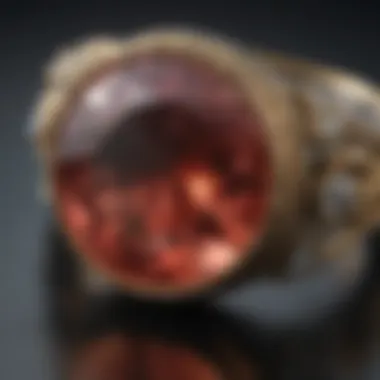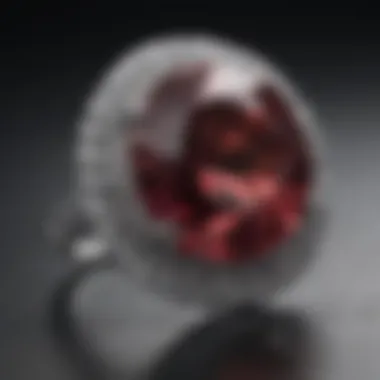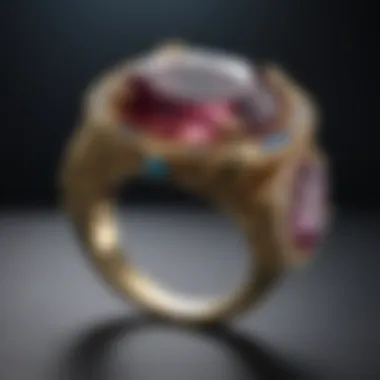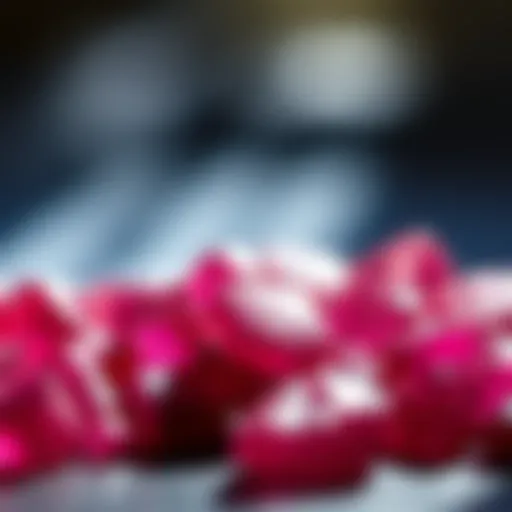Measuring Ring Size Using Paper: A Comprehensive Guide


Intro
Accurately determining ring size is a crucial practice in both jewelry making and purchasing. While most jewelers utilize professional tools for this task, not everyone has access to them. Using paper as a measuring tool presents a simple and cost-effective solution that anyone can do from the comfort of their home. This guide outlines the method in detail, highlighting the importance of precision and offering helpful instructions for a successful outcome.
Understanding how to measure your ring size with paper avoids the pitfalls of ordering rings that are too loose or tight. This can save you time, money, and frustration. Whether you are a jeweler, collector, or someone buying a ring for personal use, knowing your correct size is an essential step. Now, let’s explore the methodology.
Understanding Ring Size
Understanding ring size is vital for both the craft of jewelry making and the experience of purchasing jewelry. A precise ring size leads to comfort and maintains the aesthetic appeal of the ring. Many people may not realize that fingers are not uniformly sized, which can lead to erroneous assumptions about how a ring will fit.
Accurate sizing prevents the discomfort that arises from both overly tight and excessively loose rings. If a ring is too tight, it might cause pressure issues or even restrict blood flow. Conversely, a loose ring may slip off, leading to loss or damage. This is especially significant for valuable pieces like engagement rings or family heirlooms.
In addition, understanding ring size has broader implications beyond wearability. Jewelry is often a significant personal investment; thus, taking the time to measure correctly adds to the overall satisfaction of the piece. For jewelers and buyers alike, ensuring that a piece fits perfectly elevates its value.
The Importance of Accurate Sizing
Accurate ring sizing is not just a matter of comfort; it is essential in ensuring that the piece serves its intended purpose. Many occasions warrant the need for an accurate fit, such as weddings, anniversaries, or gift-giving. If the recipient receives a ring that does not fit, it detracts from the joy of the gift. Moreover, resizing can be costly and time-consuming.
In the context of craftsmanship, precise sizing enhances the overall quality of the work. A well-fitted ring showcases the craftsmanship involved, as the physical form of the piece complements the finger it adorns. This consideration reflects a jeweler's attention to detail, which can significantly impact customer satisfaction and reputation.
"Measuring accurately is the foundation of good jewelry design."
How Ring Sizes Are Measured
Ring sizes can be measured in various systems, with different countries adopting distinct standards. The measurement usually involves determining the inner circumference or diameter of the ring in millimeters. The common methods include using professional tools like ring sizers, but for many, such instruments may not be readily available.
The most accessible method for most individuals is using paper. With simple steps, one can measure the finger size without needing specialized tools. This method is especially beneficial in informal scenarios, such as preparing for a purchase or crafting a custom piece of jewelry.
Understanding the basics of measuring ring size will be essential as we dive deeper into the specific techniques and methods employed in using paper for this purpose.
Materials Required
When measuring ring size using paper, having the right materials is crucial. The choice of materials impacts the accuracy of the results and the ease of the process. Proper materials enhance the reliability of your measurements, making it easier to achieve a fitting ring.
Choosing the Right Paper
The type of paper you use can greatly affect your measuring experience. Lightweight and flexible paper is ideal for this task. Regular printer paper or thin cardstock can work well. Choose paper that won't easily tear when wrapping around your finger. A smooth surface helps in writing markings accurately. Opt for something that you can cut with precision, making the task easier.
Tools for Measurement
Having the right tools is as important as the paper. These tools will provide the needed precision when taking your measurements.
Scissors
Scissors are essential for cutting the paper to the right length. A good pair allows for precise and clean cuts. Sharp scissors make it less likely to tear the paper while cutting. This clean cut is crucial as small imperfections can lead to inaccuracy in measurements. Ensure that the scissors are well-maintained to avoid any jagged edges.
Tape
Tape is another vital tool in this process. It can be used to hold the paper in place while measuring. A strong adhesive ensures that the paper strip remains secure around your finger without slipping. Using tape also provides a quick way to fix any mistakes during the measurement process. Choose tape that will not damage the paper when removed.
Ruler
A ruler is necessary for accurately measuring the length of the paper used. Look for a ruler with clear markings to avoid misreading measurements. A standard ruler in centimeters or inches can work well, depending on your preference. This tool verifies that you have the precise length needed to determine your ring size. Using a ruler minimizes the potential for error in the conversion to ring sizes.
Step-by-Step Instructions
Accurate measurement of ring size is crucial for creating a comfortable and fitting piece of jewelry. The step-by-step instructions outlined in this section provide a clear pathway to ensure precision. Each step guides the reader through an effective methodology using simple materials. By following these instructions closely, one can avoid common pitfalls and achieve a reliable measurement, enhancing the overall jewelry making experience.
Preparing the Paper Strip


Begin by selecting a piece of paper. Regular printer paper or that from a notebook can suffice. Cut a strip that is approximately 10 to 15 millimeters wide and about 20 centimeters long. The width of the strip is important; it should be wide enough to wrap around your finger comfortably but not so wide that it becomes cumbersome. Using scissors, ensure the edges are clean to allow for easier wrapping and measurement.
Now, gather your tools. A ruler will be necessary for cutting the paper to the right dimensions and later measuring its length. Precision at this stage sets the foundation for the rest of the process.
Wrapping the Paper Around Your Finger
Once the paper strip is ready, it is time to wrap it around your desired finger. Select a finger that you usually wear rings on and ensure that it is at a comfortable temperature. Fingers can swell or shrink depending on temperature and time of day, which makes this factor relevant.
Carefully wrap the paper around the base of your finger. Avoid wrapping it too tightly to ensure comfort. The goal is to have the strip lie flat against the skin without constricting it. This method simulates how a ring would fit on the finger. Ensure that the overlap of the strip occurs naturally.
Marking the Measurement
With the paper strip securely wrapped around your finger, take a pen or pencil to mark where the two ends meet. This marked point is critical as it determines the size of your ring. Be precise; a slight miscalculation can result in an incorrect ring size. After marking, carefully remove the strip from your finger without altering the measurement.
It's useful to take a moment here to double-check the mark. This small task can save you from potential errors later in the process.
Measuring the Length of the Strip
Now that you have the strip marked, it is time to measure its length. Lay the strip flat on a ruler. Measure the length from the start of the strip to the mark you just made. It might help to write down this measurement for your records.
Having an accurate length is vital for converting this measurement to the corresponding ring size. Since each size corresponds to a specific measurement, this step is key to achieving your desired fit.
By taking careful steps to prepare, wrap, mark, and measure the paper strip, you set yourself up for success in determining an accurate ring size. Following these instructions with diligence can lead to a satisfying jewelry creation experience.
Understanding the Measurements
Measuring ring size accurately is critical for ensuring a perfect fit, which can influence comfort and appearance. The process of understanding these measurements has several key implications. First, it allows individuals, jewelers, and collectors to make informed decisions regarding ring purchases. Understanding the nuances of measurements can help in avoiding common pitfalls such as purchasing a ring that is too tight or loose, which can lead to discomfort or even loss of the ring altogether.
Additionally, this knowledge enhances one's ability to identify the right size in various scenarios. For instance, temperatures can influence finger size, and recognizing this can be essential when measuring. Other factors include fluctuations in body weight or time of day, all of which might affect finger dimensions. Thus, a comprehensive understanding equips individuals to navigate these variables effectively.
Converting Measurements to Ring Sizes
Once the strip of paper is measured, the next step is to convert that measurement into a standard ring size. This process often involves using a conversion chart that maps millimeters or inches to various ring sizes. Each region may have distinct sizing systems; thus, knowing the appropriate system is vital. Common systems include US, UK, and European ring sizes.
To convert your measurement:
- Measure the length of your paper strip in millimeters or inches.
- Refer to a ring size conversion chart corresponding to your region.
- Locate the measurement you obtained and find the corresponding ring size.
When sourcing a conversion chart, it is crucial to ensure it corresponds to the measurement system you are utilizing. An incorrect chart could lead one to inaccurate sizes, affecting fit and comfort. For instance, the US ring size 7 translates to approximately 54.4mm.
Ring Size Charts
Ring size charts serve as invaluable tools for both professionals and amateurs alike. A well-organized chart presents a clear reference for converting measurement lengths into numbers that correspond to actual sizes. Most charts also show half and quarter sizes, which can be quite important for achieving that snug fit.
Common details included in these charts:
- Ring sizes in both millimeters and inches.
- Notations for half sizes, providing flexibility.
- Indications for varying sizing systems for international users.
Utilizing an accurate ring size chart can eliminate much of the guesswork associated with sizing. It's advisable to keep several formats of these charts handy, as they can differ based on the source.
"Understanding how to convert your measurements accurately is essential for everyone involved in jewelry making or purchasing. Incorrect sizes can lead to frustration and disappointment."
Common Mistakes to Avoid
Measuring ring size correctly using paper is a straightforward process. However, certain mistakes can lead to inaccurate results. Recognizing and avoiding these common pitfalls is key to achieving precise measurements. Erroneous sizing can result in ill-fitting rings, causing discomfort or leaving the wearer disappointed. This section will delve into two frequent mistakes, helping you to navigate this procedure effectively.
Incorrect Wrapping Technique
One of the most common errors is the wrapping technique. When wrapping the paper around your finger, it is essential to ensure that the paper is snug but not too tight. An overly tight wrap could yield a smaller measurement, while a loose wrap will give a larger size, affecting the accuracy significantly. Ideally, the paper should be pressed gently against the finger, accounting for natural fluctuations throughout the day, like size variations from temperature.


If you find you are pressing too hard or allowing the paper to slide, take a moment to adjust. Practicing this technique a few times can help. Use one finger to stabilize the paper while you wrap with the other. This approach can help achieve a consistent measurement. Take care to avoid pinching the skin, as this might cause a misleading reading.
Misreading the Measurement
After wrapping the paper, the next step involves marking where it overlaps. Misreading this mark is another prevalent mistake. Ensure you are focused when marking the point where the papers meet. If you accidentally mark a different spot or misjudge the overlap, your measurement will not reflect the true size of your finger.
When measuring, it can be helpful to have proper lighting. Dark or poorly lit environments might cause confusion. After marking, it is critical to lay the strip flat and measure the length accurately using a ruler or measuring tape. Double-checking the measurement against a sizing chart can also prevent misinterpretations.
Accuracy in measurements is not just about achieving the perfect ring size. It speaks to your attention to detail and personal care in the jewelry choice process.
In summary, avoiding these common mistakes requires vigilance and awareness of technique. With careful execution, you can achieve the accurate ring measurement necessary for a comfortable fit.
Alternative Techniques for Measuring Ring Size
When it comes to determining the correct ring size, having multiple methods available can be invaluable. While measuring ring size using paper is accessible, alternative techniques can offer different benefits, especially for those without the required materials. Understanding these methods allows individuals to choose the most suitable approach for their needs. This is particularly useful for jewelers, collectors, and casual buyers who may require flexibility in their measuring options.
Using a Ring Sizer Tool
A ring sizer tool is a common alternative for measuring ring size. It often comes as a set of various sizes that can be slid onto the finger to determine the proper fit. These tools are typically made of plastic or metal and provide a quick and efficient way to measure one's ring size accurately.
*
- The precision of a ring sizer tool can eliminate the chance of measurement error that sometimes occurs with paper methods.
- They can be reused and can offer a handy solution for future ring resizing.
*
- Not all ring sizer tools are created equally. Some may not have accurate size increments, leading to misleading measurements.
- Depending on where you purchase the tool, there may be a need to invest a certain amount of money, which might not be feasible for everyone.
For those seeking an easy, quick solution without needing to create anything, a ring sizer tool can be beneficial. However, one must ensure the tool is calibrated correctly before use to avoid mistakes.
Utilizing String or Ribbon
Another straightforward method for measuring ring size is using a piece of string or ribbon. This technique is incredibly simple and requires only the string or ribbon itself, making it very accessible.
- Process:
- Benefits:
- Take a piece of string or a ribbon about 6 inches long.
- Wrap it snugly around the finger where the ring will sit.
- Mark the point where the string or ribbon overlaps.
- Measure the length from the end of the string to the marked point with a ruler.
- This method is typically more comfortable than others, as it adjusts well to various finger sizes.
- It can provide a close approximation of one’s size without requiring specific tools.
*
- The string must be snug but not too tight. Being overly constrictive can lead to an inaccurate measurement, especially if the finger is swollen or larger than normal.
- Users should be mindful of the material of the string; some materials, like elastic, might stretch and give misleading results.
This technique, while simple, can yield reasonable results, especially if followed with care. With a string or ribbon in hand, measuring can be done quickly without extra tools.
Using alternative techniques such as a ring sizer tool or string can provide accessibility and convenience for measuring ring size accurately. Ultimately, having various methods enables individuals to make informed decisions when selecting ring sizes.
Considerations for Different Ring Types
When measuring ring size, one must take into account the type of ring being considered. This is crucial because not all rings fit the same way. Elements such as width and design can significantly influence the fit of the ring. Therefore, understanding the nuances between wide and thin rings, as well as external factors like temperature, can greatly improve the accuracy of the sizing process.
Wide Rings vs. Thin Rings
Wide rings typically have a larger surface area that contacts the finger. This means that they can feel tighter than thinner bands of the same size. When deciding on a size for wide rings, it’s advisable to size up. A width of 6 mm or more is usually where this consideration becomes relevant. For example, if your measurement suggests a size 7, you might want to try a size 8 for a wide ring.
On the other hand, thin rings often fit more loosely. They can slide more easily over the knuckle, which can create a misleading sense of fit. To mitigate this, individuals may want to even size down slightly, especially for bands under 3 mm in width.
Key points for consideration include:


- Fit Variability: Wide rings might necessitate a larger size than standard, whereas thin rings may require a more precise or even smaller measurement.
- Style Implications: The ring’s style and design can modify how snugly it fits on the finger. Intricate designs may further increase tension.
Adjusting for Temperature and Time of Day
Another important factor when measuring ring size is the influence of temperature and time of day on finger size. Fingers can swell due to warmth or activity and become slimmer when they are cold. It’s advisable to measure at a neutral temperature, typically during the afternoon when the body is at a normal temperature.
- Temperature Influence: Warm days can cause fingers to enlarge. Conversely, cold temperatures can create a tighter fit. Knowing this can assist in making adjustments.
- Activity Level: Measuring after prolonged physical activity may lead to larger finger sizes due to temporary swelling.
For optimal measurement, consider the following:
- Avoid sizing when you are very hot or cold.
- Aim for a moment during the day when your body feels relaxed.
"Measuring ring size should be done in comfort to avoid discrepancies caused by temperature and activity."
By taking these considerations into account, one can achieve a greater likelihood of a satisfactory fit, minimizing the chances of needing adjustments later.
Maintaining Fit Over Time
Understanding how to maintain the fit of a ring over time is essential for anyone who uses paper techniques for sizing. As one’s body changes, so too can finger size. Factors such as temperature, weight fluctuations, and even hydration levels can influence finger dimensions. Recognizing these elements is vital to ensure long-lasting comfort and style.
Changes in finger size often go unnoticed until a ring becomes uncomfortably tight or slips off during daily activities. Regular attention to this aspect can prevent loss or discomfort. Ensuring that you take the time to reassess and understand these changes can lead to greater satisfaction with your jewelry choices.
Understanding Finger Size Changes
Finger size is not static; it is subject to variations over time. Factors contributing to these changes include:
- Weight Changes: Significant weight gain or loss can alter the circumference of the fingers.
- Temperature Variations: Cold temperatures often cause fingers to shrink, while heat can lead to temporary swelling.
- Time of Day: Fingers can swell slightly during the day due to fluid retention, making it essential to pick the right moment for measuring.
Being aware that your fingers may change encourages you to check your ring size periodically. This simple practice can save you from the discomfort of a ring that is too tight or too loose.
When to Reassess Ring Size
Deciding when to reassess your ring size is an important consideration. It is advisable to evaluate the fit of your ring during key times in life:
- Seasonal Changes: With every change in season, reassess your size. Summer heat and humidity can lead to swelling, while winter cold may tighten the fit.
- Weight Fluctuations: If you have experienced significant weight gain or loss, it is critical to check if your ring still fits well.
- Lifestyle Changes: Significant changes in your activity level, such as starting a new exercise routine, can impact finger size.
Regular assessments will help in maintaining comfort and security when wearing rings. If you notice any signs of a poor fit, consider measuring your size again using paper or other methods.
Remember: A small adjustment can make a significant difference in maintaining the integrity of your ring’s fit over time.
Culmination
The conclusion of this guide on measuring ring size using paper is crucial for understanding the overall significance of precise sizing. It is not simply a matter of personal preference; accurate measurements can impact comfort and the longevity of wear. Rings, which are often symbols of commitment or closely tied to personal style, deserve attention to detail in their size.
When implementing the techniques discussed in the article, both casual jewelry buyers and professionals will benefit. Correct measurements reduce the likelihood of resizing later due to improper fit. People may appreciate the aesthetics of a ring or its craftsmanship, but if it does not fit correctly, it can lead to discomfort or even loss. Understanding how to measure accurately can enhance one's experience, providing peace of mind that the size chosen will be appropriate.
Additionally, the insights on maintaining the fit over time help to reinforce the need for periodic reassessment. Factors such as those discussed in the sections about seasonal changes and fluctuations in body temperature can affect finger size.
In summary, this comprehensive exploration not only empowers readers with the knowledge to correctly determine ring size but also builds a foundation for informed decision-making and enhances the appreciation of jewelry craftsmanship.
Summary of Key Points
The key points of this guide include:
- The significance of accurate ring sizing to ensure a good fit.
- Detailed instructions for measuring using simple materials such as paper.
- Common mistakes to avoid, ensuring readers can confidently measure their size.
- Considerations for variations in ring styles and personal circumstances.
- The importance of maintaining fit over time, recognizing changes in finger size.
Emphasizing these points can prevent issues later on and contribute to a satisfying ring-wearing experience.
Encouragement for Precise Measurement
Precision in measurement should not be taken lightly. The step-by-step instructions provided are designed to facilitate accurate sizing with minimal tools. Engagement in the process fosters a better understanding of personal jewelry preferences.
For collectors and jewelers alike, correct sizing offers insight into their inventory and can lead to significant business advantages. As diverse styles exist, recognizing the individuality of each person's fit preferences can enhance satisfaction with any piece. Moreover, taking the time to measure properly sets a standard for future purchases and design considerations.
Ultimately, the act of measuring one's ring size may feel simple but has profound implications. It involves embracing both the practicality and sentiment behind jewelry. Thus, implementing the strategies discussed in this guide ensures an outcome that celebrates both skill and artistry.







